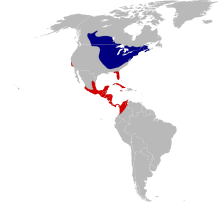Baltimore oriole
| Baltimore oriole | |
|---|---|
 |
|
| Adult male | |
 |
|
| Adult female | |
| Scientific classification | |
| Kingdom: | Animalia |
| Phylum: | Chordata |
| Class: | Aves |
| Order: | Passeriformes |
| Family: | Icteridae |
| Genus: | Icterus |
| Species: | I. galbula |
| Binomial name | |
|
Icterus galbula (Linnaeus, 1758) |
|
 |
|
| Range of I. galbula Breeding range Wintering range | |
The Baltimore oriole (Icterus galbula) is a small icterid blackbird common in eastern North America as a migratory breeding bird. It received its name from the resemblance of the male's colors to those on the coat-of-arms of Lord Baltimore. Observations of interbreeding between the Baltimore oriole and the western Bullock's oriole, Icterus bullockii, led to both being classified as a single species, called the northern oriole, from 1973-1995. Research by James Rising, a professor of zoology at the University of Toronto, and others showed that the two birds actually did not interbreed significantly.
The Baltimore oriole is the state bird of Maryland. It is also the inspiration for the Baltimore Orioles baseball team.
Like all New World orioles, this species is named after an unrelated, physically similar family found in the Old World: the Oriolidae. "Oriole" ultimately derives from Latin aureolus, "golden". The genus name Icterus is from Ancient Greek ikteros, a yellow bird, usually taken to be the Eurasian golden oriole, the sight of which could cure jaundice. The specific galbula is the Latin name for a yellow bird, again usually assumed to be the golden oriole.
This medium-sized passerine measures 17–22 cm (6.7–8.7 in) in length and spans 23–32 cm (9.1–12.6 in) across the wings. Their build is typical of icterids, as they have a sturdy body, a longish tail, fairly long legs and a thick, pointed bill. The body weight averages 33.8 g (1.19 oz), with a range of weights from 22.3 to 42 g (0.79 to 1.48 oz). The male oriole is slightly larger than the female, although the size dimorphism is minimal by icterid standards. Adults always have white bars on the wings. The adult male is orange on the underparts shoulder patch and rump, with some birds appearing a very deep flaming orange and others appearing yellowish-orange. All of the rest of the male's plumage is black. The adult female is yellow-brown on the upper parts with darker wings, and dull orange-yellow on the breast and belly. The juvenile oriole is similar-looking to the female, with males taking until the fall of their second year to reach adult plumage.
...
Wikipedia

